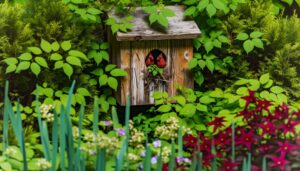10 Steps to Successfully Call a Cardinal to Your Garden
To call a Northern Cardinal, replicate their vocalizations such as the 'cheer-cheer-cheer' and 'chip' calls with precise frequency, duration, and pitch variations. Conduct observations and attempts during peak vocalization periods, typically early morning and late afternoon.
Utilize bird call devices that mimic cardinal songs with high fidelity and consider spectrogram analysis to ensure precision. The appropriate setting, such as a bird-friendly yard with indigenous plantings and suitable feeders, will enhance your efforts.
For a thorough understanding of cardinal calling and additional strategies, a deeper examination of their ethology and vocalization behaviors is warranted.

Key Takeaways
- Learn cardinal calls by practicing their 'cheer-cheer-cheer' and 'chip' vocalizations with attention to frequency, duration, and pitch.
- Use bird call devices that replicate cardinal songs accurately and have adjustable volume controls.
- Observe peak vocalization times, such as early morning and late afternoon, for increased chances of successful communication.
- Set up a welcoming yard with indigenous plants, water features, and dense foliage to attract cardinals naturally.
- Provide the right food, including black oil sunflower seeds, safflower seeds, cracked corn, and fruits, to draw cardinals to your yard.
Understanding Cardinal Behavior
To effectively call a cardinal, it is necessary to first understand their behavioral patterns, including their vocalizations, territoriality, and mating rituals.
Cardinals demonstrate distinct vocalizations, such as the characteristic 'cheer-cheer-cheer' calls used for communication and territory defense. Territorial behavior is marked by aggressive displays and frequent patrolling of boundaries, ensuring exclusive access to resources.
During mating season, males engage in elaborate courtship displays involving song duets with females and presentation of food items. Recognizing these behaviors provides valuable insights into their communication modalities and social structures.
Understanding these elements enables one to mimic natural sounds and behaviors accurately, thereby increasing the likelihood of successfully attracting a cardinal. Detailed knowledge of cardinal ethology therefore serves as a foundational step in effective avian interactions.
Choosing the Right Time
Best timing for calling a cardinal hinges on understanding their diurnal activity patterns, with peak vocalization periods occurring during early morning and late afternoon hours. These periods coincide with heightened territorial and mating behaviors, making them ideal for eliciting responses.
Observations indicate that Northern Cardinals (Cardinalis cardinalis) are most vocally active between dawn and 10 a.m., and again from 4 p.m. to dusk. This timing aligns with their foraging and nesting activities. Environmental factors such as temperature, light levels, and predator presence also influence their calling behavior.
It is advisable to avoid mid-day attempts, as cardinals typically exhibit reduced vocal activity during this time. Understanding these temporal patterns increases the likelihood of successful communication with this species.
Learning Cardinal Calls
Understanding the best timing for calling cardinals is fundamental, but mastering their vocalizations requires a precise knowledge of their distinct calls and songs. Cardinals exhibit a repertoire of vocalizations, including the characteristic 'cheer-cheer-cheer' song and the sharp 'chip' call used for alarm.
Accurate replication involves recognizing the frequency, duration, and pitch variations inherent in these sounds. Males primarily use complex songs to establish territory and attract mates, while both sexes employ simpler calls for communication and alerting conspecifics to potential threats.
Detailed attention to these auditory cues, combined with practice, enables effective imitation of cardinal calls, facilitating successful avian interactions. Proficiency in these vocalizations enhances the observer's capacity to attract and engage with cardinals in their natural habitat.
Using Bird Call Devices
Incorporating bird call devices into your avian interaction toolkit offers a scientifically validated method for accurately replicating cardinal vocalizations. These devices, often equipped with digital recordings, can emulate the frequency, pitch, and rhythm of cardinal songs with high fidelity. By utilizing spectrogram analysis, manufacturers guarantee that the acoustic signatures mirror those of natural cardinal calls.
Observational data indicate that cardinals exhibit positive responses to these artificial calls, often approaching the source. When selecting a bird call device, prioritize models with adjustable volume controls and diverse call libraries to match different behavioral contexts.
Practitioners should conduct periodic maintenance checks to ensure peak sound quality, thereby maximizing the efficacy of the interaction and study of these vibrant songbirds.
Setting Up Your Yard
Creating an ideal setting for attracting cardinals involves strategic placement of feeders, indigenous plantings, and water features, each chosen to meet the species' specific habitat preferences. Cardinals flourish in areas that offer sufficient shelter, food, and water.
To optimize your yard for cardinals, consider the following:
- Indigenous Plantings: Integrate shrubs and trees such as dogwood, serviceberry, and elderberry, which provide both shelter and food.
- Water Features: Set up birdbaths with gently sloping sides to accommodate the cardinals' bathing habits.
- Shelter: Offer dense foliage or evergreen trees to provide protection from predators and harsh weather.
- Ground Cover: Provide a variety of ground cover plants to facilitate foraging and nesting.
These components create a welcoming environment that caters to the cardinal's ecological needs.
Selecting the Best Feeders
Selecting the most effective feeders for cardinals requires choosing models that cater to their size, feeding habits, and preferences for specific seed types, such as sunflower seeds and safflower seeds.
Tube feeders with wider perches provide stability for these medium-sized birds. Hopper feeders, with their larger capacity and sheltered design, prevent seeds from becoming wet and moldy. Platform feeders, offering ample space, accommodate cardinals' reluctance to feed in confined spaces.
Additionally, feeders with built-in baffles deter unwanted species and pests. Ensuring feeders are constructed from weather-resistant materials, such as metal or high-grade plastic, prolongs their usability. Finally, placing feeders at heights of 5-6 feet and near shrubs or trees provides cardinals with a sense of security against predators.
Offering the Right Food
Providing a nutritionally balanced diet is essential for attracting and sustaining a healthy population of cardinals in your backyard. Cardinals exhibit a preference for specific food types that fulfill their dietary requirements. Key nutritional offerings include:
- Black Oil Sunflower Seeds: High lipid content provides energy essential for daily activities.
- Safflower Seeds: Rich in protein, supporting muscle maintenance and overall health.
- Cracked Corn: A significant carbohydrate source aiding in energy production.
- Fruit and Berries: Vitamins and antioxidants present in fruits enhance immune function.
Observations indicate cardinals frequent feeders stocked with these items, ensuring consistent visitation. Ensuring a varied diet encompassing these elements will optimize nutritional intake and attract a vibrant cardinal population to your habitat.
Providing Water Sources
Ensuring an adequate supply of water is essential for attracting cardinals, necessitating strategic birdbath placement to maximize accessibility and safety from predators.
Fresh water must be replenished frequently, approximately every 1-2 days, to maintain cleanliness and prevent stagnation.
Additionally, seasonal variations in temperature and humidity dictate adjustments to water availability, with heated birdbaths recommended during colder months to prevent freezing.
Birdbath Placement Tips
Strategically situating a birdbath to maximize accessibility and visibility for cardinals involves considering factors such as proximity to cover, ideal water depth, and the avoidance of potential predator habitats. Optimal placement can greatly improve the chance of attracting cardinals.
Key considerations include:
- Closeness to Vegetative Cover: Place the birdbath near shrubs or trees to provide quick escape routes from predators.
- Height: Position the birdbath at a height of 2-3 feet to deter ground predators and allow cardinals to feel secure.
- Water Depth: Maintain a water depth of 1-2 inches, suitable for cardinals' bathing preferences.
- Unobstructed Visibility: Ensure the birdbath is in a clear area to allow cardinals to spot potential threats while using the water source.
These guidelines improve cardinal visitation effectively.
Fresh Water Frequency
Maintaining a reliable source of fresh water is crucial for attracting and sustaining cardinal populations in your garden. Cardinals require consistent hydration, making it essential to provide water that is both clean and readily accessible.
Observational data indicates that water sources should be refreshed daily to prevent contamination from algae, bacteria, or debris. A shallow birdbath with a depth of 1-2 inches is ideal, guaranteeing ease of access for cardinals while minimizing drowning risks.
Additionally, the implementation of a water circulation system, such as a fountain or dripper, can enhance attraction by mimicking natural water sounds. Regular maintenance, including scrubbing with a non-toxic solution, is vital to maintain the water remains uncontaminated and appealing to cardinals.
Seasonal Water Needs
As seasons change, the water requirements for cardinals also fluctuate, necessitating adjustments in the provision and maintenance of water sources to guarantee their hydration needs are effectively met year-round. This adaptability guarantees optimal hydration and ecological stability.
Key considerations include:
- Winter: Prevent water sources from freezing by using heated bird baths or adding warm water periodically.
- Spring: Increase water availability to support breeding and nesting activities.
- Summer: Guarantee water sources are shaded to maintain cooler temperatures and reduce evaporation.
- Autumn: Clean and replenish water sources more frequently to accommodate migratory patterns and increased activity.
Understanding these seasonal variations is essential for maintaining the well-being of cardinals in varying climatic conditions, ensuring their survival and ecological contribution.
Creating a Safe Environment
Ensuring a cardinal's habitat is free from predators and environmental hazards is essential for fostering a safe environment conducive to their well-being. Effective measures include the strategic placement of dense shrubbery and thorny plants, which serve as natural deterrents to potential threats. Additionally, maintaining a clean environment by removing fallen fruits and seeds can prevent attracting unwanted pests.
| Environmental Factor | Recommended Action |
|---|---|
| Predators | Install birdhouses with small entrances to exclude larger predators. |
| Food Safety | Regularly clean feeders to inhibit mold and bacteria growth. |
| Shelter | Plant native vegetation to provide natural cover and nesting sites. |
These strategies collectively create a secure habitat, promoting cardinal health and encouraging their presence.
Conclusion
To sum up, the alignment of understanding cardinal behavior, selecting best times, mastering calls, and utilizing bird call devices greatly improves the likelihood of attracting cardinals.
Providing appropriate feeders, food, and water sources, alongside creating a secure environment, further enhances this objective.
Through meticulous observation and technical precision, the delicate balance of these factors results in a scientifically sound approach to calling cardinals, ultimately fostering a harmonious interaction with these avian creatures.


